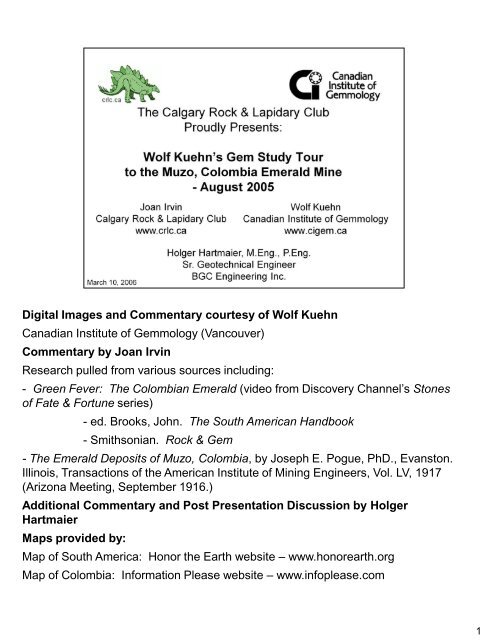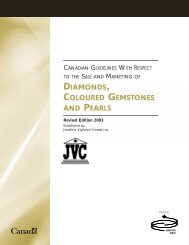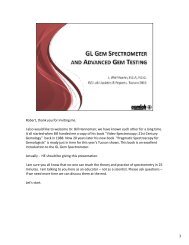Colombian Emeralds - Canadian Institute of Gemmology
Colombian Emeralds - Canadian Institute of Gemmology
Colombian Emeralds - Canadian Institute of Gemmology
Create successful ePaper yourself
Turn your PDF publications into a flip-book with our unique Google optimized e-Paper software.
Digital Images and Commentary courtesy <strong>of</strong> Wolf Kuehn<br />
<strong>Canadian</strong> <strong>Institute</strong> <strong>of</strong> <strong>Gemmology</strong> (Vancouver)<br />
Commentary by Joan Irvin<br />
Research pulled from various sources including:<br />
- Green Fever: The <strong>Colombian</strong> Emerald (video from Discovery Channel’s Stones<br />
<strong>of</strong> Fate & Fortune series)<br />
- ed. Brooks, John. The South American Handbook<br />
- Smithsonian. Rock & Gem<br />
- The Emerald Deposits <strong>of</strong> Muzo, Colombia, by Joseph E. Pogue, PhD., Evanston.<br />
Illinois, Transactions <strong>of</strong> the American <strong>Institute</strong> <strong>of</strong> Mining Engineers, Vol. LV, 1917<br />
(Arizona Meeting, September 1916.)<br />
Additional Commentary and Post Presentation Discussion by Holger<br />
Hartmaier<br />
Maps provided by:<br />
Map <strong>of</strong> South America: Honor the Earth website – www.honorearth.org<br />
Map <strong>of</strong> Colombia: Information Please website – www.infoplease.com<br />
1
Introduction<br />
<strong>Emeralds</strong> are found in relatively few countries around the world. Recent<br />
deposits have been found in Canada’s north. Historical sources are few<br />
and far between -- Pakistan, Russia’s Ural Mountains, Zambia &<br />
Zimbabwe in Africa, and Brazil & Colombia in South America.<br />
Colombia reputedly boasts the best emeralds in the world, at one time<br />
producing 80-90% <strong>of</strong> the world’s production. Current production is<br />
estimated to be about 60%. Most <strong>of</strong> the emeralds come from two major<br />
mining districts Muzo and Chivor located respectively north and east<br />
northeast <strong>of</strong> Bogotá. The images we will be seeing here are from the<br />
mines near Muzo; Colombia’s largest and most famous mine. It is<br />
located in the province <strong>of</strong> Boyaca, north <strong>of</strong> Bogotá, Colombia’s capital.<br />
All images were taken by Wolf Kuehn <strong>of</strong> the <strong>Canadian</strong> <strong>Institute</strong> <strong>of</strong><br />
<strong>Gemmology</strong> in Vancouver during a trip to Colombia in the summer <strong>of</strong><br />
2005.<br />
2
Colombia is the fourth largest country in South America, with coast lines<br />
on both the Atlantic and Pacific. Its lowlands are largely uninhabited,<br />
whereas the narrow valleys and high basins between its mountains<br />
support over 90% <strong>of</strong> the population. The climate is hot, resulting in a<br />
daily cycle <strong>of</strong> evaporation from the marshy lands, followed by torrential<br />
rainfalls and fog. The lushly forested landscape is punctuated with<br />
crops such as maize, potatoes, sugar cane, c<strong>of</strong>fee, and cacao (from<br />
which chocolate is derived).<br />
3
The human population in Colombia is almost as colourful as its<br />
butterflies. You will find descendants <strong>of</strong> the indigenous Indian<br />
population, along with those <strong>of</strong> the conquistadors and black slaves.<br />
Intermarriage adds to this rainbow.<br />
4
The flora and fauna <strong>of</strong> Colombia are also colourful and exotic. This is a<br />
land <strong>of</strong> parrots, lizards, and the occasional jaguar.<br />
5
Mineral treasures also abound. Quartz may occur as well formed,<br />
colourless to greenish (rare) crystals in the emerald veins. Inclusions <strong>of</strong><br />
pyrite and emerald have been noted, indicating that the quartz crystals<br />
formed after the emeralds.<br />
6
<strong>Emeralds</strong> were prized by the natives <strong>of</strong> Colombia, long before the Conquistadores<br />
arrived. The Indians treasured them as symbols <strong>of</strong> fertility and immortality,<br />
incorporated them into their gold work, and used them as currency in barter. Over<br />
the years these stones have caused much strife. The Muzo area came under<br />
Spanish control in 1567, when the natives were enslaved by the Conquistadors and<br />
put to work in the mines. The power struggle for control <strong>of</strong> this resource continues<br />
to this day.<br />
Let’s take a look at the last half <strong>of</strong> the 20th century. Up until 1947, the mines <strong>of</strong><br />
Muzo were administered by the Bank <strong>of</strong> the Republic. Looting was rampant. In<br />
1968, the state created a mining corporation (Esmeralda <strong>of</strong> Colombia) to take<br />
control. They doled out claims and contracts to private families, but the robberies<br />
and violence continued until the army was forced to close the mines in 1973. In<br />
1976, private consortia picked up the reins, but a free-for-all ensued, featuring rival<br />
guerrilla groups, and even drug cartels. (Note: per gram, uncut emeralds are worth<br />
fifty times more than drugs. Even on the streets <strong>of</strong> Bogotá, 1,500 carats <strong>of</strong> rough<br />
crystals will fetch a quarter million dollars). The ensuing “Green Wars” claimed<br />
thousands <strong>of</strong> lives. It wasn’t until 1991, when Pablo Escobar and another big drug<br />
lord were killed by the army, that “relative peace” returned to the region. That said,<br />
7
security remains tight around Muzo today. And while this may<br />
discourage outside attacks, it does little to address the problem <strong>of</strong><br />
workers swallowing stones to smuggle them <strong>of</strong>fsite.<br />
7
The Muzo emerald mining district covers an area <strong>of</strong> about 360 square<br />
km, centered about 105 km north-northwest <strong>of</strong> Bogotá, in the western<br />
foothills <strong>of</strong> the eastern branch <strong>of</strong> the Andes at about 700 metres above<br />
sea level. Local relief is less than 500 metres. It consists <strong>of</strong> three major<br />
mining centres, Muzo, Coscuez and Penas Blancas. The Muzo mine is<br />
located about 8 km west <strong>of</strong> the village <strong>of</strong> Muzo.<br />
The Chivor district is located on the eastern slopes <strong>of</strong> the Andes about<br />
75 km east-northeast <strong>of</strong> Bogotá. The district occupies about 100<br />
square km in very rugged country, cut by canyons 1000 metres or more<br />
deep. The Chivor mine is located at an elevation <strong>of</strong> 2300 metres above<br />
sea level. The two currently active and most important mines in the<br />
Chivor district are the Chivor and the Gachala.<br />
8
The town <strong>of</strong> Muzo is located along the valley <strong>of</strong> Rio Minero. The mine is<br />
located within a steep walled valley <strong>of</strong> Quebrada del Desaguadero. The<br />
dashed area outlines the Muzo mining preserve. The mining area is<br />
composed <strong>of</strong> many individual “cortes” or mines which are on long term<br />
leases from the <strong>Colombian</strong> government.<br />
9
These next few shots are <strong>of</strong> the town <strong>of</strong> Muzo, in the province <strong>of</strong><br />
Boyaca. They’ll give you an idea <strong>of</strong> the <strong>Colombian</strong> landscape. The<br />
emerald mining district is within 16 km <strong>of</strong> the town.<br />
10
The emerald deposits around Muzo were originally worked by the Incas<br />
up to 2000 years ago and were “rediscovered” by the Spanish in 1559.<br />
There has been a long history <strong>of</strong> intermittent production from these<br />
mines continuing to the present day.<br />
11
The mines have been owned by the government since 1871 and have<br />
been leased to various operators since then. Five year leases were<br />
instituted in 1977 and discontinued in 1982 due in part to poor recovery<br />
brought about by rapid mining techniques (dynamite and bulldozers).<br />
Ten year leases were most recently held by two companies Tecminas<br />
and Coesminas, who developed underground workings.<br />
12
While the best way to avoid ambush enroute to the mine is to travel by<br />
helicopter, this just isn’t an option for most workers. Here we have a<br />
shot taken along the road to the Muzo mine, located about 8 km west <strong>of</strong><br />
the town <strong>of</strong> Muzo.<br />
13
We are now in emerald country.... The region around the deposits is<br />
characterized by intense tropical jungle and excessive heat. Jungle<br />
growth quickly obscures abandoned workings and makes exploration<br />
very difficult and costly.<br />
“It is a 4 hour gruesome four-wheel drive for the 80 kms from<br />
Chiquichira at 2,200 m down into the valley. I was the only "tourist" and<br />
many <strong>of</strong> the locals on the jeep got sick. The scenery is absolutely<br />
spectacular. But most emerald dealers use the helicopter and "miss<br />
out" on the adventure.” – Wolf Kuehn<br />
14
…and have arrived at the mine.<br />
15
While the Muzo mine covers an area the size <strong>of</strong> a small city, this shot<br />
will give you an idea <strong>of</strong> the traditional open-cast mine, in combination<br />
with newer technologies (if you look part way up the slope, perhaps you<br />
will note a shaft). The Muzo Mine was worked long before the arrival <strong>of</strong><br />
the conquistadors. Little is known about the early history <strong>of</strong> the mine.<br />
Local lore states that it was found by the Spanish when a horseman<br />
riding around the town <strong>of</strong> Muzo noticed a green stone wedged between<br />
the ho<strong>of</strong> and shoe <strong>of</strong> his steed. Upon investigation and questioning the<br />
local Indians he learned that these green stones could be found just<br />
outside <strong>of</strong> town.<br />
16
Traditional mining methods are used that differ little from those used by<br />
the Spaniards in the 16 th century. Nearly all work is by hand. The<br />
bedrock is a s<strong>of</strong>t shale and explosives are rarely used to break the rock,<br />
only when it is free <strong>of</strong> emerald bearing veins. The emerald bearing<br />
strata on steep mountainsides are cut into steps about 2 m high and 3-4<br />
m wide by gangs <strong>of</strong> miners using picks and crowbars. Using this open<br />
cut method, literally every cubic metre <strong>of</strong> rock is examined and emerald<br />
recovery approaches 100%. The broken waste rock is removed mostly<br />
by flushing with water. Large reservoirs are located in the hills above<br />
the workings and are filled directly by streams or by water diverted long<br />
distances by dug canals. The force <strong>of</strong> the water effectively washes<br />
away all the broken rock into the valley below.<br />
17
The broken waste rock washed from the mine accumulates in the valley<br />
bottom below the mine. Here there is no shortage <strong>of</strong> peasant<br />
“shovellers” eager to eke out a living in the sludge. They sift through<br />
thousands <strong>of</strong> tons <strong>of</strong> rock, and if they are lucky may find a few handfuls<br />
<strong>of</strong> emeralds per day.<br />
18
It has been estimated that the grade <strong>of</strong> the emerald bearing rock is<br />
about 1 carat for every 15 cubic metres <strong>of</strong> rock. Assuming a bulk<br />
density <strong>of</strong> 2.2 g/cubic cm, the ratio <strong>of</strong> emerald to rock is 1:165 million,<br />
making the overall emerald grade <strong>of</strong> the ore 0.0000006%! This is more<br />
than 10 times leaner than the grade <strong>of</strong> South African diamond bearing<br />
kimberlites.<br />
19
The great value <strong>of</strong> the emerald makes security at the mines a problem.<br />
Members <strong>of</strong> the National Police guard and oversee operations at all<br />
legally worked emerald mines. Bonuses are paid to miners who spot<br />
smears <strong>of</strong> emerald (moralla) in the rock that lead to discovery <strong>of</strong> a<br />
productive vein or pocket.<br />
20
In the mines, a month or more <strong>of</strong> mining commonly separates<br />
discoveries which may contain in volume not more than a s<strong>of</strong>t ball,<br />
gems worth from a few thousand to several million dollars.<br />
21
Annual production <strong>of</strong> emeralds from Colombia is not known with any<br />
degree <strong>of</strong> accuracy due to clandestine operations. Average yearly<br />
production from 1964-1967 was 325,000 carats, much <strong>of</strong> it low grade<br />
stones.<br />
22
New technologies, such as underground mining, have been introduced<br />
by players such as Rio Verde (Green River), a Vancouver company.<br />
Further up the mountain we can see what looks like power generators,<br />
probably for the pneumatic drills that will be used to dig into the thin<br />
white calcite veins that contain the emeralds, when a pocket can be<br />
found.<br />
23
The advantage <strong>of</strong> underground mining is that the amount <strong>of</strong> waste rock<br />
mined may be reduced, assuming that a productive vein can be<br />
followed. The disadvantage <strong>of</strong> this method is the need to use<br />
explosives, which damage the emeralds. Also the underground<br />
openings need to be supported and ventilated. As you can see, mining<br />
methods are rather primitive and potentially unsafe.<br />
24
...and these next few shots are inside the hot muggy mine. In the dark,<br />
it is difficult to see much at all. The large pipes deliver ventilation to the<br />
working face.<br />
25
Here we can see the poorly lit and wet conditions in the adit leading to<br />
the working face.<br />
An “adit” is a mining term for a horizontal opening into the ground that<br />
only has one entrance, as opposed to a tunnel which is open at both<br />
ends. In mining terms a shaft is a vertical opening into the ground.<br />
26
Relatively few timbers are noted here, indicating good ground<br />
conditions.<br />
27
Here we see one <strong>of</strong> the calcite veins that emeralds are <strong>of</strong>ten found in.<br />
The host rock is a black carbonaceous and calcareous shale. The<br />
calcite vein material would be brought to the surface and broken up by<br />
hand to remove any emerald crystals present.<br />
28
…and here we see a miner with a handful <strong>of</strong> stones – probably the fruits<br />
<strong>of</strong> an entire day’s labour. Only the most trusted employees are allowed<br />
near the working face <strong>of</strong> the mine. In some mines, the best stones are<br />
placed into leather pouches for protection after extraction.<br />
29
Here we get a closer look at some raw emeralds.<br />
30
...and this is Wolf Kuehn on the left (Director <strong>of</strong> the <strong>Canadian</strong> <strong>Institute</strong> <strong>of</strong><br />
<strong>Gemmology</strong>, the gentleman who took these photos) and Jesus Tajeado,<br />
his Muzo guide.<br />
“I will say the trip was one <strong>of</strong> my greatest adventures and I will go back<br />
as soon as I can. However, I would not recommend an excursion to<br />
Muzo for group travel or inexperienced tourists. Spanish and familiarity<br />
with local customs are an absolute must.” - Wolf Kuehn<br />
J. Wolf Kuehn, C.I.G. Director <strong>of</strong> Education, is a Fellow <strong>of</strong> the Gemmological Association <strong>of</strong><br />
Germany. He is a pr<strong>of</strong>essional member <strong>of</strong> the "British Columbia College <strong>of</strong> Teachers" and holds a<br />
Master's degree in Marketing (University <strong>of</strong> Augsburg). As the founder <strong>of</strong> the <strong>Canadian</strong> <strong>Institute</strong> <strong>of</strong><br />
<strong>Gemmology</strong> (Instituto de Gemologia del Pacifico - Pacific <strong>Institute</strong> <strong>of</strong> Gemology) he has been<br />
involved in gemology for over 30 years. Among his publications the Gem Colour Manual and the<br />
Gemstone Inclusion Library has been widely recognized as a valuable tool for colour grading and<br />
serious gem identification<br />
31
At last we leave the mine behind.<br />
32
…and return to Muzo. But let’s have a closer look at some emeralds.<br />
33
Here we can see a lovely emerald crystal in calcite. Note the prismatic<br />
crystal, which is hexagonal in structure. <strong>Emeralds</strong> are a member <strong>of</strong> the<br />
beryl family, obtaining their unique colour from trace amounts <strong>of</strong><br />
chromium and vanadium. They can be green or blue green, but<br />
<strong>Colombian</strong> emeralds are unique in that they exhibit a complete lack <strong>of</strong><br />
iron. (The pyrite <strong>of</strong>ten found nearby seems to have attracted it all.)<br />
34
Again – another specimen<br />
<strong>Emeralds</strong> can be transparent to translucent. Their value is primarily in<br />
their colour, which is enhanced by their natural fluorescence in daylight.<br />
The famous “emerald cut” further enhances a stone’s colour and<br />
richness.<br />
35
Another shot... <strong>Emeralds</strong> have a hardness <strong>of</strong> 7 ½ to 8, with imperfect<br />
cleavage. Fractures are uneven to conchoidal.<br />
36
Here we have multiple specimens...<br />
37
...and more <strong>of</strong> the same, with a finished faceted stone.<br />
38
…the same thing again, and a word about inclusions. The inclusions in<br />
emeralds add to their interest. These “growth features” tell us how the<br />
stones grew in nature, and provide us with information on what<br />
temperatures they were formed at, what solutions they were formed<br />
from, and so on.<br />
39
Here we see a faceter at work. As most <strong>of</strong> you know, a cutter can add<br />
to the value <strong>of</strong> a stone -- or take it away in one false move! <strong>Emeralds</strong><br />
are usually cut in the…guess what… the emerald cut!<br />
40
Here we have a lovely sampling <strong>of</strong> cut stones. Emerald is the birthstone for May.<br />
Colour and clarity are highly variable and are major factors in valuation. Nearly all<br />
stones have inclusions, and the best coloured usually have the most inclusions. The<br />
term “jardin” (meaning garden) is used for mossy appearing, densely included<br />
stones. Good stones <strong>of</strong> high clarity and colour are extremely rare in sizes above 2-3<br />
carats. Colour is highly prized with large carat, but weakly coloured stones up to<br />
five carats being worth less than smaller included stones <strong>of</strong> better colour. Most<br />
natural stones are “oiled” to improve clarity. Traditional oils include Canada Balsam<br />
and cedarwood oil. This treatment is used to seal the cracks in the crystals. Seven<br />
times rarer than diamonds, these stones will fetch a small fortune once they leave<br />
the country. Commercial grade emeralds will cost buyers approximately<br />
$1,000/carat in Colombia. Exceptional stones <strong>of</strong> 5 carats or more have been sold for<br />
as much as $25,000/carat! Before they leave the country, these stones must be<br />
registered, appraised, and approved for export (for a fee, <strong>of</strong> course). Moving<br />
emeralds is still risky business. The possibility <strong>of</strong> <strong>Colombian</strong> gangs following a<br />
dealer to Canada or the US is not unheard <strong>of</strong>, but unscrupulous customs agents<br />
enroute can be equally devastating to a gem dealer. Perhaps that is one justification<br />
for the twenty-fold price jump that occurs between the <strong>Colombian</strong> emerald mine and<br />
the North American jewellery store.<br />
41
Emerald is the gem variety <strong>of</strong> beryl.<br />
42
The gem varieties <strong>of</strong> beryl are all the same composition, but owe their<br />
colours to trace amounts <strong>of</strong> different elements that substitute for the<br />
Aluminum in the crystal lattice and act as chromophores.<br />
43
The rocks hosting the Muzo emerald deposits are <strong>of</strong> middle Cretaceous age, based chiefly on the<br />
abundant ammonites that are found with them.<br />
The geology <strong>of</strong> the Muzo emerald deposits is still poorly understood, due to its checkered history<br />
and poor exposures <strong>of</strong> bedrock in the region. The best exposures are in the working mine faces,<br />
as abandoned workings are quickly covered by jungle vegetation. The emerald formation (see<br />
slide) consists <strong>of</strong> thin beds <strong>of</strong> carbonaceous shale and limestone. There is an angular<br />
unconformity between the emerald bearing rock units and the barren rock units <strong>of</strong> early<br />
Cretaceous age below. It is believed that the younger emerald bearing rock units were thrust on<br />
top <strong>of</strong> the older, steeply dipping strata by large scale tectonic displacements. At the same time<br />
as this deformation was taking place, hydrothermal fluids were being injected along the fault<br />
zone, bringing in the emerald bearing solutions. Calcite veins were formed in both the barren<br />
and emerald bearing rock units, however, it is believed that gases emanating from the solution<br />
rose into the rock units above the fault and were responsible for depositing the emeralds<br />
preferentially. The barren rock units called the “cambiado” (Spanish for changed-<br />
metamorphosed) were only subjected to the hot hydrothermal fluids and were not affected by the<br />
gases. The rock units between the emerald formation and the cambiado were literally cooked to<br />
a crumbly ash-like unit called the cenizero (Spanish for ash), which forms a marker between the<br />
emerald and non-emerald bearing rocks. Obviously, more investigative work is required to fully<br />
understand the geology <strong>of</strong> these deposits.<br />
44
Here’s a list <strong>of</strong> the other minerals that are found in association with the<br />
emeralds at Muzo. Many <strong>of</strong> them are well formed and good specimens<br />
in their own right. They are no doubt <strong>of</strong> particular chemical interest in<br />
understanding the origin and formation <strong>of</strong> the emerald deposits.<br />
45









